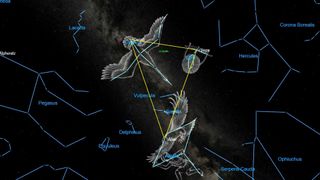See the Summer Triangle asterism after dusk Wednedsay (Aug. 31)
See summer’s favorite asterism rise above the eastern horizon just after dusk on Wednedsay (Aug. 31).

See summer's favorite asterism rise above the eastern horizon just after dusk tonight (Aug. 31).
The Summer Triangle asterism (a general term for a grouping of stars) consists of three bright, white stars from three separate constellations: Deneb in the constellation Cygnus the Swan, Vega in the constellation Lyra the Harp, and Altair in the constellation Aquila the Eagle. When you connect these three stars in the night sky they form a triangle that is visible high overhead all night.
While this star pattern is an annual feature of the northern summer sky and remains visible until the end of December, it is particularly prominent through July and August — so now’s the perfect time to catch it!
Related: Night sky, August 2022: What you can see tonight [maps]
In late August, Vega, Deneb and Altair are the first stars to appear as the sky darkens. The brightest star of the bunch (and the brightest star in the summer sky) is Vega at magnitude 0.03, followed by magnitude 0.75 Altair located to the lower right. Deneb shines somewhat less brightly to the lower left with a magnitude of 1.25.
Vega and Altair are located relatively close, sitting only 25 light-years and 17 light-years away from the sun, respectively. Meanwhile, Deneb is located a staggering 2,600 light-years away. Despite this great distance, Deneb shines so brightly because of its greater intrinsic luminosity, according to geophysicist and amateur astronomer Chris Vaughan who oversees Space.com's Night Sky calendar.

Looking for a telescope to see the summer triangle? We recommend the Celestron Astro Fi 102 as the top pick in our best beginner's telescope guide.
The Summer Triangle can be clearly seen in the night sky with the naked eye. And, under clear, dark skies you may even be able to spot the Milky Way galaxy between Vega and Altair and through Deneb. The trio will set in the west as dawn begins to break.
Get the Space.com Newsletter
Breaking space news, the latest updates on rocket launches, skywatching events and more!
If you're looking for a telescope or binoculars with which to observe the Summer Triangle, our guides for the best binoculars deals and the best telescope deals now can help. Our best cameras for astrophotography and best lenses for astrophotography can also help you prepare to capture the next skywatching sight on your own.
Editor's Note: If you snap a photo of the Summer Triangle and would like to share it with Space.com's readers, send your photo(s), comments, and your name and location to spacephotos@space.com.
Follow Samantha Mathewson @Sam_Ashley13. Follow us on Twitter @Spacedotcom or on Facebook.
Join our Space Forums to keep talking space on the latest missions, night sky and more! And if you have a news tip, correction or comment, let us know at: community@space.com.

Samantha Mathewson joined Space.com as an intern in the summer of 2016. She received a B.A. in Journalism and Environmental Science at the University of New Haven, in Connecticut. Previously, her work has been published in Nature World News. When not writing or reading about science, Samantha enjoys traveling to new places and taking photos! You can follow her on Twitter @Sam_Ashley13.
